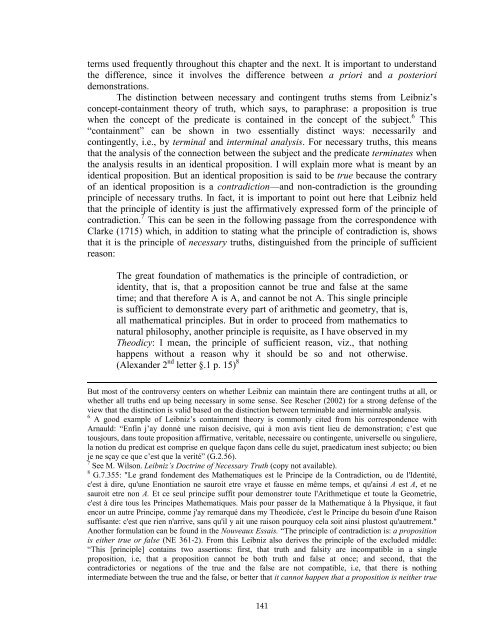Stony Brook University
Stony Brook University
Stony Brook University
You also want an ePaper? Increase the reach of your titles
YUMPU automatically turns print PDFs into web optimized ePapers that Google loves.
terms used frequently throughout this chapter and the next. It is important to understand<br />
the difference, since it involves the difference between a priori and a posteriori<br />
demonstrations.<br />
The distinction between necessary and contingent truths stems from Leibniz’s<br />
concept-containment theory of truth, which says, to paraphrase: a proposition is true<br />
when the concept of the predicate is contained in the concept of the subject. 6 This<br />
“containment” can be shown in two essentially distinct ways: necessarily and<br />
contingently, i.e., by terminal and interminal analysis. For necessary truths, this means<br />
that the analysis of the connection between the subject and the predicate terminates when<br />
the analysis results in an identical proposition. I will explain more what is meant by an<br />
identical proposition. But an identical proposition is said to be true because the contrary<br />
of an identical proposition is a contradiction—and non-contradiction is the grounding<br />
principle of necessary truths. In fact, it is important to point out here that Leibniz held<br />
that the principle of identity is just the affirmatively expressed form of the principle of<br />
contradiction. 7 This can be seen in the following passage from the correspondence with<br />
Clarke (1715) which, in addition to stating what the principle of contradiction is, shows<br />
that it is the principle of necessary truths, distinguished from the principle of sufficient<br />
reason:<br />
The great foundation of mathematics is the principle of contradiction, or<br />
identity, that is, that a proposition cannot be true and false at the same<br />
time; and that therefore A is A, and cannot be not A. This single principle<br />
is sufficient to demonstrate every part of arithmetic and geometry, that is,<br />
all mathematical principles. But in order to proceed from mathematics to<br />
natural philosophy, another principle is requisite, as I have observed in my<br />
Theodicy: I mean, the principle of sufficient reason, viz., that nothing<br />
happens without a reason why it should be so and not otherwise.<br />
(Alexander 2 nd letter §.1 p. 15) 8<br />
But most of the controversy centers on whether Leibniz can maintain there are contingent truths at all, or<br />
whether all truths end up being necessary in some sense. See Rescher (2002) for a strong defense of the<br />
view that the distinction is valid based on the distinction between terminable and interminable analysis.<br />
6 A good example of Leibniz’s containment theory is commonly cited from his correspondence with<br />
Arnauld: “Enfin j’ay donné une raison decisive, qui à mon avis tient lieu de demonstration; c’est que<br />
tousjours, dans toute proposition affirmative, veritable, necessaire ou contingente, universelle ou singuliere,<br />
la notion du predicat est comprise en quelque façon dans celle du sujet, praedicatum inest subjecto; ou bien<br />
je ne sçay ce que c’est que la verité” (G.2.56).<br />
7 See M. Wilson. Leibniz’s Doctrine of Necessary Truth (copy not available).<br />
8 G.7.355: "Le grand fondement des Mathematiques est le Principe de la Contradiction, ou de l'Identité,<br />
c'est à dire, qu'une Enontiation ne sauroit etre vraye et fausse en même temps, et qu'ainsi A est A, et ne<br />
sauroit etre non A. Et ce seul principe suffit pour demonstrer toute l'Arithmetique et toute la Geometrie,<br />
c'est à dire tous les Principes Mathematiques. Mais pour passer de la Mathematique à la Physique, it faut<br />
encor un autre Principe, comme j'ay remarqué dans my Theodicée, c'est le Principe du besoin d'une Raison<br />
suffisante: c'est que rien n'arrive, sans qu'il y ait une raison pourquoy cela soit ainsi plustost qu'autrement."<br />
Another formulation can be found in the Nouveaux Essais. “The principle of contradiction is: a proposition<br />
is either true or false (NE 361-2). From this Leibniz also derives the principle of the excluded middle:<br />
“This [principle] contains two assertions: first, that truth and falsity are incompatible in a single<br />
proposition, i.e, that a proposition cannot be both truth and false at once; and second, that the<br />
contradictories or negations of the true and the false are not compatible, i.e, that there is nothing<br />
intermediate between the true and the false, or better that it cannot happen that a proposition is neither true<br />
141
















